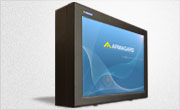Keeping Optimal Working Conditions for Outdoor Digital Signage
Posted by: Richard Williams | Posted on: | 0 Comments
Outdoor digital signage is becoming widespread and for a myriad of differing applications–outdoor advertising, information screens and outdoor entertainment are now found in most towns and cities and it’s not just big business and advertising companies that can get involved.
Even smaller businesses and institutions are reaping the benefits of using outdoor screens. From retailers to schools, churches to community halls, using screens outdoors is enabling effective and engaging communication for all sorts of users.
Outdoor environments are very different to indoor ones, and using screens in these locations requires coping with the variable environmental challenges.
Standard commercial and consumer LCD screens require weatherproofing to prevent rainfall and other elements for disabling the screen, but screens have a finite operating temperature too. When ambient temperatures exceed these limits, an LCD screen will fail, so providing the optimal working conditions is essential for standard screens.
LCD enclosures are more than juts waterproof casings for LCD screens. The enclosure acts as an environmental housing ensuring the enclosed LCD is running at the optimum operating conditions, regardless of the ambient temperature.
Using different climatic systems, an LCD enclosure is a customizable solution, enabling outdoor LCD use in almost any outdoor location.
For locations where extremely high temperatures are a problem, cooling systems inside the LCD enclosure maintain a steady temperature; even in extreme heat, air conditioners provide a constant low temperature within operating limits.
For some locations, direct sunlight is often a factor, especially if it is shining directly on the screen face. Direct sunlight can lead to permanent damage to LCD screen causing scorch marks and adding to the overheating. Using a stream of cool air blown across the screen’s surface, an LCD enclosure carries this heat away, preventing any heat build-up and preventing any screen burn.
Extreme cold can disable a screen just as easily as heat. LCD enclosures ensure the screen operates above the minimum operating temperature using several different techniques. Firstly, insulating the enclosure can harness the heat generated by the screen. Secondly, by using thermostatically controlled internal heaters, the internal temperature is maintained regardless of how low the ambient gets. LCD enclosures have been successfully used in temperatures as low as -30 degrees centigrade.
Post shortlink:
Popular Products
LCD Enclosure
Need armor for your LCD/LED screen(s)? Outdoors or inside the versatile LCD enclosure protects against thieves, vandals & the weather. Installation idea: NFL stadiums.
Outdoor Digital Signage
Exclusive 46” outdoor screen protection. Dubbed the ‘Totem’, due to its distinct design, it repels damage threats, but attracts audiences. Installation idea: Drive-thru restaurants.
Portrait Flat Panel Enclosure
Safeguard your eye-level advertising display screen(s), indoors or outdoors. Completely customizable, add exciting features like touch screen technology. Installation idea: Restaurant frontages.
Indoor Digital Signage
Popular purchase for retail outlets! Great for ‘point of sale’ persuasion, boost your brand with static & motion advertising from a single unit! Installation idea: Mall of America.




